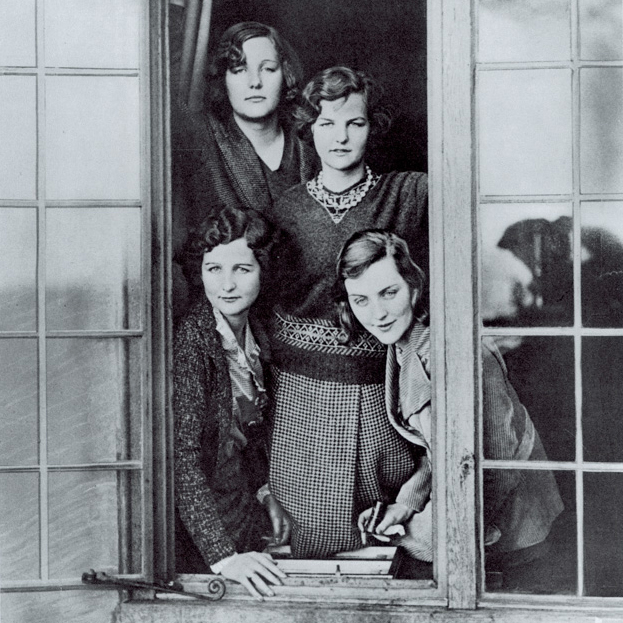The Pursuit of Love, Nancy Mitford’s finest novel, opens with a vignette that evokes the uncanny blend of domestic intimacy and world-historical trauma experienced by the author and her six younger siblings—Pamela, Tom, Diana, Unity, Jessica, and Deborah:
There is a photograph in existence of Aunt Sadie and her six children sitting round the tea-table at Alconleigh. The table is situated, as it was, is now, and ever shall be, in the hall, in front of a huge open fire of logs. Over the chimney-piece plainly visible in the photograph, hangs an entrenching tool, with which, in 1915, Uncle Matthew had whacked to death eight Germans one by one as they crawled out of a dug-out. It is still covered with blood and hairs, an object of fascination to us as children.
By the time this semi-autobiographical work, where Uncle Matthew is modeled on Nancy’s father, Lord Redesdale, was published in late 1945, the paterfamilias’s fictional victims seemed to have extracted posthumous revenge on the formerly charmed lives of his children’s real-life counterparts. Unity had a bullet lodged in her brain—the result of a failed suicide attempt at the outbreak of the Second World War using a pistol given to her by Adolf Hitler—which would finally kill her a few years later. Diana was reviled as a traitor thanks to her own admiring association with the Führer and marriage to the British Fascist leader Oswald Mosley. Jessica—as devoted to Communism as her sisters were to Fascism—had lost her husband, Esmond Romilly, an air-force officer who never returned from a mission over Germany. And Tom, also a Fascist sympathizer, had been killed late in the war fighting the Japanese in Burma.
Stiff-Upper-Lipped
Nancy, we learn in Laura Thompson’s 2003 biography of the author, Life in a Cold Climate—now being published in the U.S. for the first time—appeared outwardly unruffled by this torrent of misery. Upon learning, while at a friend’s house, of her beloved brother’s death, she emerged “smiling more brightly than ever” and “came down with the other guests to sit among the jewel-coloured birds at dinner.”
The Pursuit of Love displays a similar sense of self-control. Throughout the novel, Nancy’s clipped prose strikes a tone of wry amusement as the heroine, Linda Radlett, graduates from “the Hons’ cupboard”—the aristocratic Radlett girls’ hideaway in their freezing country house—to successive failed marriages, political activism, and true love in the shape of Fabrice, a dashing French Resistance hero. That gift for sublimating pain into plucky comic fiction reflects what Thompson calls Nancy’s “spiky carapace, her laughing defence against hurt.” Only in the novel’s final pages do we catch a fleeting glimpse of authentic anguish, when Linda dies in childbirth, echoing Nancy’s own ectopic pregnancy, which left her infertile.
Upon learning of her beloved brother’s death, Nancy Mitford emerged “smiling more brightly than ever.”
Faced with a subject whose internal life often remains elusive, Thompson herself adopts an essentially Mitfordian approach. Rather than fixate on Nancy’s bruised psyche, she provides a breezy account of her many misfortunes and belated triumphs as the daughter of a tyrannical father and neglectful mother who became a Bright Young Thing in 1920s London, an unloved wife in the 30s, and a best-selling author after the war. In an effervescent style that seems to channel Nancy’s own writing, Thompson challenges us to embrace the Mitfords’ singular sense of fun. That collective wit consisted of a flair for looking at the dark side and delivering a mordant bon mot (thence the bloody entrenching tool hanging over the children’s portrait in The Pursuit of Love). Failure to get the joke was to commit the one unforgivable faux pas of being a crashing bore.
Among those who fell into that category was Nancy’s husband, Peter Rodd. Though not entirely humorless—he once declined a party invitation from Nazi ambassador Joachim von Ribbentrop in Yiddish—“Prod” (as Nancy called him) was also dubbed “the old Tollgater” because of his fondness for holding forth on the intricacies of the English tollgate system. They married in 1933—when Nancy was approaching 30 and on the rebound from the gay aristocrat Hamish St. Clair-Erskine—but the union soon began to disintegrate under the pressure of Rodd’s infidelities and drink-fueled fecklessness (though they only divorced in the late 1950s).
True love finally emerged during the war in the shape of Gaston Palewski, Free French leader Charles de Gaulle’s right-hand man and the model for Fabrice in The Pursuit of Love and its companion volume, Love in a Cold Climate, whom Nancy followed to Paris in 1945, remaining there for most of the rest of her life. But their affair, which continued into the 1960s, brought Nancy only qualified happiness—Palewski refused to acknowledge her publicly, fathered a child by another lover, and eventually married a rich divorcée. The priapic, spotty-faced “Colonel” (another one of Nancy’s nicknames, this time for Palewski) also lacked Fabrice’s idealized gallantry. His seduction methods purportedly included answering the door stark naked before an unsuspecting lunch guest. And whereas “everyone wanted to go to bed with Fabrice,” writes Thompson, in Palewski’s case, “he wanted to go to bed with everyone.”
Flaws and All
Thompson’s scrupulousness in separating fact from fiction is paralleled by her attentiveness to Nancy’s flaws, such as her brief flirtation, emulating Unity, Diana, and Tom, with Mosley’s Blackshirts in the mid-1930s, whereafter she espoused mildly left-wing views and even worked in a refugee camp for Spanish Republicans in southern France. Nancy’s reputation for snobbery—cemented by her tongue-in-cheek 1955 magazine article distinguishing between “U” (i.e., upper-class) and “non-U” forms of speech—was probably undeserved. But she was not free from prejudice and thought her Moroccan servant, who nursed her while she was dying of cancer in the early 1970s, shouldn’t have the right to vote. Though royalties from her books, which included popular biographies of Madame de Pompadour and Louis XIV, made her a rich woman, she also had a habit of obtusely pleading poverty.
That late success came from hard, unglamorous work, accompanied by relative domestic calm. The final third of Thompson’s book thus inevitably becomes a bit humdrum. But in her account of the author’s eccentric upbringing, romantic travails, and politically charged family feuds, she captures the essence of the Mitford spirit—“so light and airy, so dark and remorseless,” as Thompson puts it—that Nancy both defined and transcended.
Max McGuinness is the New York theater critic for the Financial Times


